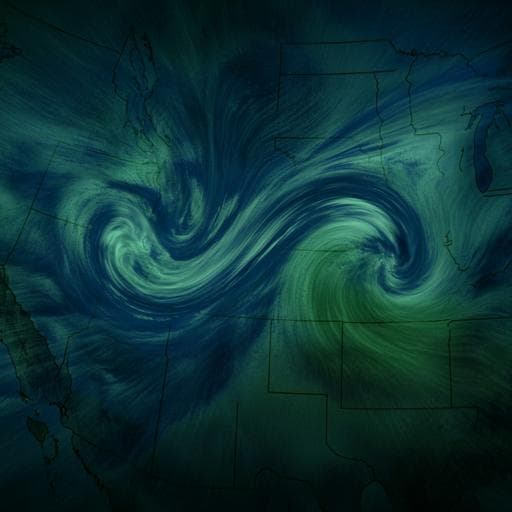
Earth Sciences
Atmospheric rivers impacting western North America in a world with climate intervention
C. A. Shields, J. H. Richter, et al.
Dive into groundbreaking research by Christine A. Shields, Jadwiga H. Richter, Angeline Pendergrass, and Simone Tilmes, exploring how stratospheric aerosol injections impact atmospheric rivers in western North America. Discover how this innovative climate intervention could reshape rainfall patterns by the end of the century!
~3 min • Beginner • English
Introduction
Atmospheric rivers (ARs) are long, narrow synoptic-scale features that transport large amounts of moisture and are often linked to extratropical cyclones. Western North America, especially coastal regions and mountain ranges such as the Sierra Nevada and Cascades, is strongly influenced by ARs, which can deliver over half of annual precipitation in places like California, ranging from beneficial to flood-inducing events. With warming, ARs are expected to grow and carry more moisture, potentially increasing extremes. Stratospheric aerosol injection (SAI) has been proposed as a solar geoengineering method to reduce some impacts of warming but carries uncertainties and risks. The study aims to understand the consequences of SAI for western North American ARs using Earth System Model simulations from GLENS that maintain near-2020 global and hemispheric temperature gradients via time-varying SO2 injections at multiple latitudes. The research addresses: (1) projected end-of-century changes in western North American ARs under SAI, (2) differences relative to near-term (circa 2020) conditions, and (3) contrasts with a no-intervention high-emissions scenario (RCP8.5). This context is critical for water resource management and adaptation planning in AR-dependent regions such as California.
Literature Review
Prior work establishes ARs as key to regional precipitation and hydrology across western North America, with climate change expected to increase AR size, moisture content, and extremes. Debates on geoengineering highlight uncertainties and governance needs; modeling frameworks (GeoMIP) have explored solar reduction and prescribed aerosols, but earlier designs (e.g., equatorial injections) produced over/undercooling biases. Kravitz et al. proposed multi-latitude SO2 injections to meet simultaneous temperature objectives, reducing spatial biases. The GLENS project applied this approach in CESM1(WACCM), generating large-ensemble simulations to better capture internal variability. Previous GLENS and GeoMIP studies documented hydrological and dynamical consequences of SAI (e.g., shifts in westerlies, polar ocean warming, seasonal cycle changes). However, focused analysis on western North American ARs, particularly the "Pineapple Express" subtype, has been limited. Uncertainties in AR detection across algorithms (ARTMIP) are substantial, motivating careful method choice and acknowledgment of detection-tool-related spread.
Methodology
Model and experiments: Analyses use CESM1 with WACCM (CESM1(WACCM)), a fully coupled high-top ESM with 0.9°×1.25° atmosphere and 70 vertical levels to ~140 km, interactive chemistry (MAM3 aerosols), POP2 ocean, CICE4 sea ice, and CLM4.5 land. GLENS provides a 20-member ensemble of geoengineered runs with time-varying SO2 injections at 15°S, 15°N, 30°S, and 30°N, 5 km above the tropopause, adjusted annually by a feedback control algorithm to maintain near-2020 global mean temperature, interhemispheric gradient, and equator-to-pole gradient under RCP8.5 forcing. Control ensembles include RCP8.5 runs for 2010–2030 (20 members) and three members extended to at least 2097.
Analysis periods: Three comparisons are made: (1) GLENS end-of-century (EC: 2080–2097) vs RCP8.5 EC; (2) GLENS EC vs BASE (near-term control: 2010–2030 RCP8.5); (3) RCP8.5 EC vs BASE.
Diagnostics: Background climate fields include annual mean surface temperature, precipitation, and integrated vapor transport (IVT). AR dynamics assessed via zonal wind (U), especially low-tropospheric levels (e.g., 700 hPa), with seasonal and latitudinal decomposition and significance via Student’s t-test (95%). AR frequency changes are expressed as percent relative to reference periods, and significance defined by non-overlapping ensemble member distributions between compared periods.
AR identification: The Shields & Kiehl (2016) AR detection tool (SK2016), a restrictive, relative method, identifies ARs using anomalies of integrated water vapor (IWV) relative to zonal climatology (following Zhu & Newell relationship) and low-level wind magnitude thresholds (85th percentile regionally). The study domain focuses on western North America (32°–52°N), restricting to landfalling ARs originating from the southwest quadrant (the "Pineapple Express" subtype). Geometrical filters require features longer than wide (≥2:1) and minimum length 200 km. ARs are detected at 6-hourly intervals; AR-attributable precipitation uses 6-hourly data. The method saves source IWV and wind fields at landfall rather than imposing a fixed AR footprint.
Precipitation analyses: Cool-season (Oct–Mar) total precipitation changes are mapped, with AR-precipitation contributions quantified and intensity distributions evaluated by latitude bands (32–35°N, 35–37°N, 37–41°N, 41–52°N) and longitude ranges (110–130°W or 116–130°W per band). Water-year (Nov–Oct) accumulated AR precipitation is compared across scenarios using ensemble ranges. Statistical significance for distribution differences is identified when ensemble spreads do not overlap.
Significance and sampling: Ensemble means and spreads are used. Noted limitations include only three RCP8.5 EC members, and 20-year sampling windows for EC and BASE.
Key Findings
- Under SAI (GLENS EC vs RCP8.5 EC), low-level zonal winds weaken in mid-latitudes (40°–60°N) and strengthen equatorward of ~40°N during the cool season, indicating an equatorward shift in relevant steering flow; AR frequency changes mirror these wind changes.
- Regional AR frequency impacts: In SAI simulations by end-century, ARs increase for southern California latitudes and decrease for the Pacific Northwest and coastal British Columbia, consistent with low-level wind shifts. Under RCP8.5 EC vs BASE, signals are generally opposite to SAI.
- Compared to near-term (GLENS EC vs BASE), AR frequency increases in lower mid-latitudes are muted and often not statistically significant; limited significance is attributed partly to sampling duration and ensemble sizes.
- Precipitation impacts: Cool-season total precipitation under SAI shows drying north of ~35–40°N relative to RCP8.5 EC, and hints of increased precipitation in southern California relative to BASE, with drier conditions in the Pacific Northwest.
- AR-attributable precipitation intensity distributions under SAI shift from higher to more moderate rates across latitude bands, most pronounced at lower latitudes. Under RCP8.5 EC, more extreme AR precipitation rates occur relative to SAI and BASE.
- Despite hints of increased precipitation in southern California under SAI vs BASE, differences in AR precipitation intensity distributions are generally small and lack significance, suggesting AR precipitation intensity in a geoengineered world could be similar to today.
- Seasonal accumulation: Across scenarios, most AR precipitation accumulates between October and March. Under SAI vs RCP8.5 EC, the ensemble range of water-year AR accumulation narrows at lower latitudes. Under SAI vs BASE, accumulated AR precipitation increases notably for southern California, even where intensity distributions change little.
- Contribution ratios: The fraction of cool-season precipitation from ARs remains relatively consistent across scenarios and latitude bands, with southern California up to ~42% and the Pacific Northwest under ~10% across ensemble members.
Discussion
The study directly addresses the three research questions. (1) Under SAI by end-century, AR landfalls and associated precipitation patterns are governed by dynamical changes in the low-level jet: AR frequency increases in southern California and decreases in the Pacific Northwest and coastal British Columbia; AR precipitation intensity shifts toward moderate rates with fewer extremes. (2) Relative to near-term (BASE), SAI produces muted and often insignificant changes in AR frequency and intensity across most latitudes, indicating that SAI maintains AR precipitation characteristics closer to today’s climate, while still increasing total AR-related accumulation in southern California. (3) Without intervention (RCP8.5), AR-related precipitation becomes more extreme and storm tracks shift differently than under SAI, leading to higher rainfall rates and increased intensity, consistent with thermodynamic moisture increases in a warmer climate. These findings emphasize that AR responses follow dynamical steering flow changes: where the jet moves, AR landfalls follow. The results suggest that SAI can moderate AR-driven hydroclimatic extremes relative to an unabated warming scenario, potentially benefiting regions like southern California by preserving more moderate AR precipitation intensities, though with possible reductions in total cool-season precipitation in upper mid-latitudes (Pacific Northwest, coastal British Columbia) that are not fully explained by AR changes and may involve shifts in extratropical cyclone behavior.
Conclusion
SAI implemented via multi-latitude SO2 injections in GLENS maintains near-2020 thermal gradients and alters low-level winds such that AR frequencies increase in southern California and decrease in the Pacific Northwest by end-century. AR precipitation intensity shifts toward more moderate rates with fewer extremes compared to an unabated RCP8.5 future, while remaining broadly similar to present-day intensity when comparing SAI to near-term conditions. The hydroclimatic impact is most evident in southern California, which may see increased AR-related accumulation under SAI, whereas total cool-season precipitation likely decreases in the Pacific Northwest, implicating changes in non-AR extratropical cyclone precipitation. Overall, SAI could mitigate some AR-related extremes relative to a warmer world without intervention. Future work should: (a) expand beyond the "Pineapple Express" subtype to encompass a wider AR taxonomy and locally sourced precipitation from extratropical cyclones, (b) employ higher-resolution models and larger end-of-century ensembles, and (c) compare multiple AR detection tools to reduce methodological uncertainty.
Limitations
Key limitations include: (1) limited ensemble size for RCP8.5 at end-century (only three members) and 20-year sampling windows, which reduce statistical power and significance; (2) model horizontal resolution (~1°) affects AR frequencies, precipitation attribution, and jet placement, influencing AR landfall locations; (3) reliance on a single, restrictive AR detection tool (SK2016) focused on landfalling, southwest-originating "Pineapple Express" ARs, limiting generality and complicating comparisons with other ARDTs; (4) precipitation from extratropical cyclones not associated with subtropical moisture plumes is not captured by the ARDT used; (5) resolution dependencies and dynamical core sensitivities can alter AR characteristics; and (6) uncertainty highlighted by ARTMIP regarding AR detection and climate-change responses. These factors may affect robustness and generalizability of regional quantitative estimates.
Related Publications
Explore these studies to deepen your understanding of the subject.







